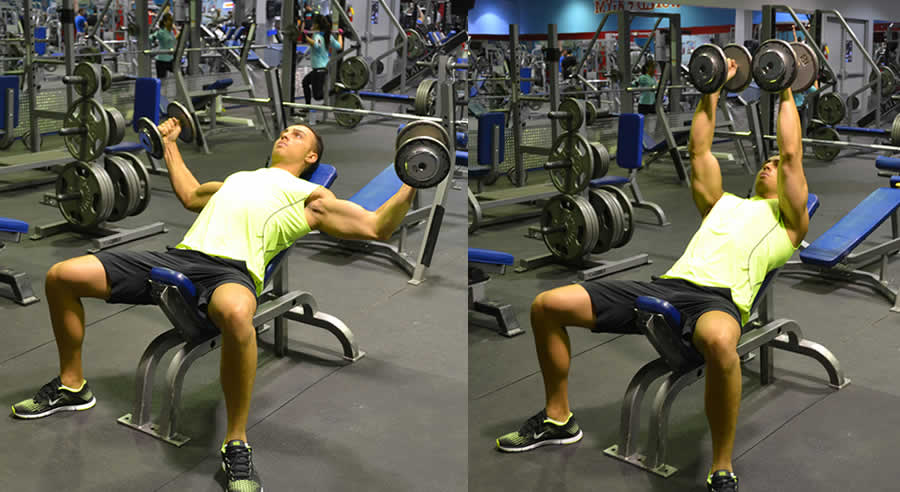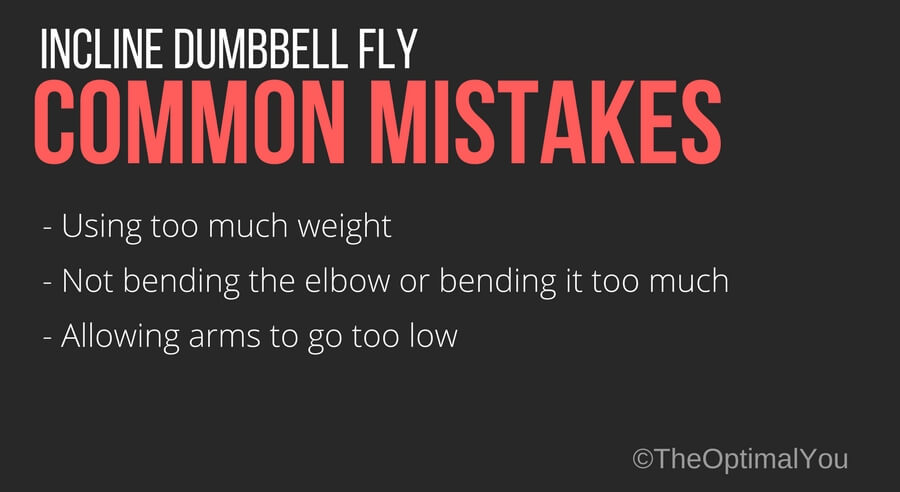Purpose of Incline Dumbbell Fly
The incline dumbbell fly is an isolated movement designed to target the clavicular head of the chest – also known as the upper pec.
Equipment Needed to Perform Incline Dumbbell Fly
To perform incline dumbbell fly, an adjustable bench, along with a pair of dumbbells are all that is required. This is one of the more practical upper chest exercises that you can include into your program due to the minimal amount of equipment needed. If only a flat bench is available, you can slightly tilt it by placing a 45 lbs. plate underneath one end of the bench to turn it into a slight incline.
Difficulty of Incline Dumbbell Fly
On a scale of 1 to 5, incline dumbbell fly would rank around a 2 in difficulty, however, just because they aren’t hard to perform, many people still have a hard time feeling the desired area working when performing them. Because the clavicular head of the pec is challenging for most people to recruit at will, extra concentration is required when performing this relatively easy movement to avoid having other nearby muscle groups like the shoulders from taking over.
How to Perform Incline Dumbbell Fly
With dumbbells in each hand, lying down on an incline bench set slightly below 45 degrees, press each dumbbell above your chest – this is the starting position. Maintain a slight bend in the elbow, and lower the weights out to your side, moving only at the shoulder joint, and only going as low as you can without experiencing discomfort. At the bottom position, pause for a brief moment, focus on the stretch, and then contract the pecs to initiate the concentric portion of the rep. DO NOT bang the dumbbells together at the top, but rather stop shy of the end range to keep the tension on the pecs. If you do want to bring the dumbbells together, do so gently, and try to press through them to intensify the contraction of the pecs – either way is acceptable.
Key Points when Performing Incline Dumbbell Fly:
- Maintain a slight bend in the elbow throughout the exercise
- Lower out to the side, as far as possible without experiencing discomfort
- Pause at the bottom, and focus on the stretch
- Either stop shy of performing a full range, or if performing a full range DO NOT bang the dumbbells together, touch them gently and then try to push through them after they’ve made contact
How Many Reps when Performing Incline Dumbbell Fly
Incline dumbbell flyes don’t particularly lend themselves to use of heavy weights, and as a result, weights that allow for 10-15 total reps to be performed is ideal. With this exercise the weight is secondary to the contraction felt during the movement.
Yes, you do want to lift as heavy as possible, but not at the expense of feeling the desired area doing the work – when the weight exceeds a certain amount, what tends to happen is other muscles begin to take over, thus defeating the purpose of selecting this exercise in the first place.
Common Mistakes when Performing Incline Dumbbell Fly
Some of the more common mistakes when performing incline dumbbell flyes are:
Going to heavy – if the weight is too heavy, the incline dumbbell flye can quickly become an incline dumbbell press. This is not necessarily a bad thing, as the incline dumbbell press is also a great exercise, but if that’s what you want to do, then you would be better off making that decision right off the bat, as it should affect where in your workout you choose to do it.
Not bending the elbow, or bending the elbow too much – failing to at least slightly bend the elbow can place a lot of unnecessary stress onto the shoulder joint, while bending the elbow too much defeats the purpose of performing a flye in the first place as it limits the range in which the pecs are able to perform quality work.
Lowering too far – the goal when performing any exercise is to train the muscles on your body through the range your body has available, NOT to train through the greatest possible range of motion at the expense of the muscles you are trying to work. As it relates to any type of flye movement, you want to lower as far as your body allows, and stretch the pecs as best you can, NOT lower the dumbbells as close to the ground as possible.
Modifications to the Incline Dumbbell Fly
There aren’t many worthwhile modifications to the incline dumbbell flye.
Yes, you could turn it into a press by bending, and extending, the elbow, and yes, you could play with the degree of incline as anything above flat, and below fully upright, would classify as “incline,” but it’s not necessary to obsess over minor details like that. Simply pick the right angle that allows you to best feel the muscles working when performing the exercise.
When to do Incline Dumbbell Fly
It would be appropriate to perform incline flyes both at the beginning, or end, of your workout, depending on your goal for using them in the first place as there are pro’s and con’s to both.
As for using them at the beginning, this would ensure that the chest is more likely to be a limiting factor when performing other compound movements designed for the chest, although you may not be able to use as much weight.
As for using them at the end, this would allow you to fully tax the chest directly, but once again you may not be able to use as much weight had you don’t them earlier in the workout.
Alternatives to Incline Dumbbell Fly
The primary alternative to incline dumbbell flyes would be incline dumbbell presses. Because of the practicality, in that you can use the exact same equipment, you can easily choose to do a press if the weights you have access to are too heavy to do flyes properly.
Incline Dumbbell Fly vs. Incline Dumbbell Presses
The primary difference between incline dumbbell flyes, and incline dumbbell presses, is that flyes provide more of a direct stimulus on the chest, while presses allow for greater loads to be used since more musculature (the shoulders, and triceps) is contributing to the movement.
A good way to extend the set, and thus increase the demand on the chest, would be to start your set by doing flyes, and when you fatigue too much to do them properly, simply switch to doing presses – this can be done without actually stopping the set to make adjustments, which is why it’s a great way to really overload the chest.
Incline Dumbbell Fly vs. Flat Dumbbell Fly
The primary difference between incline dumbbell flyes, and flat dumbbell fly is that the incline flyes target the upper chest whereas the flat flyes target the middle chest.



